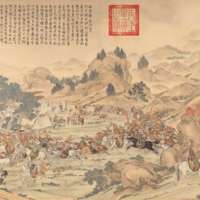Browse Exhibits (1 total)
Qing Conquest of Zungharia

The Emperor Qianlong commissioned the original set of sixteen engravings of his conquests on 13 July 1765 for the central hall of the Palace in Beijing and is recorded to have said: 'I wish the sixteen prints of the victories that I won in the conquest of the kingdom of Chumgar [Zungharia] and the neighbouring Mahommedan countries, which I had painted by Lamxinim [Castiglione] and the other European painters who are in my service in the city of Peking, to be sent to Europe where the best artists in copper shall be chosen so that they may render each of these prints perfectly in all its parts on plates of copper'.
The drawings were prepared in China by four Jesuits: Giuseppe Castiglione, the director of the project, Jean-Denis Attiret, Ignatius Sichelbarth and Jean Damascène. By recommendation of Louis-Joseph Le Febvre, head of the French Jesuit mission to China, they were sent to Paris, where the engravings were executed by eight artists under the direction of Charles-Nicolas Cochin of the Académie Royale at the Court of Louis XVI. Jean-Philippe Le Bas, Helman's master, was one of the engravers. This commission was considered of utmost importance, as it potentially offered France means of leaving a favorable impression on the Emperor and thus gaining advantage in view of commerce and missioning, directed against the Dutch, Portuguese and English. The Emperor's commission was for an edition of one hundred copies only; however, to ensure the safe receipt of at least one hundred copies in China, an edition of 200 copies was actually printed. To reduce the risk of loss at sea they were distributed over two ships in lots of 100 impressions each. The entire edition was received in China by 1775 for which the Compagnie Francaise des Indes in Canton was paid the sum of 240,000 pounds. Only a very limited number of extra copies were printed for the French King, his ministers and some members of the Court and the greatest precaution was taken that no copies remained with the engravers or printers to ensure its exclusivity.
The engravings are documented in a monograph by Michèle Pirazzoli-T'Serstevens, Gravures des Conquetes de l'Empereur de Chine K'ien-Long au Musée Guimet, Paris 1969.